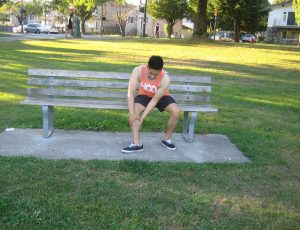Varicose veins are enlarged gnarled veins. Any vein can be affected, usually the veins found the legs and feet. It is caused by standing and walking upright which causes an increase of pressure in the veins of the lower body. Varicose veins can cause severe pain and discomfort but sometimes it can result to serious circulatory problems.
[youtube url=”https://www.youtube.com/watch?v=VPeXRCc8w24″]Symptoms of varicose veins
- Veins that becomes bluish or dark purple in appearance
- Twisted veins and bulging can oftentimes appear as cords in the legs
- An achy sensation or heaviness in the legs
- Burning, muscle cramping, throbbing and distension of the lower legs

Pain becoming severe after sitting or standing for long periods of time - Pain becoming severe after sitting or standing for long periods of time
- Bleeding from the varicose veins
- Itchiness can be felt in one or more veins
- The cord in the veins becomes painful with reddish discoloration of the skin
If there is hardening of the veins, changes in color, inflammation of the skin or development of skin ulcers close to the ankle, it is vital to seek medical help immediately.
Causes
- When an individual start to age, the veins becomes less elastic which causes them to stretch poorly. The valves of the veins are weak which makes the blood going to the heart flow backwards. Blood that accumulates in the veins becomes enlarged and result to varicose veins. The veins appear blue since deoxygenated blood are present.
- Some pregnant women usually develop the condition. These changes in circulation supports the growing fetus but leads to the enlargement of the veins found in the legs.
- Changes in the hormonal levels can also cause varicose veins.
Treatment
- Wear compression stockings all day which work by squeezing the legs to increase the circulation of blood in the area.
- Drinking plenty of water can soften stools. It provides less strain on the veins on the legs and also prevents hemorrhoids.
- Take a cold shower since it constricts the superficial veins by stimulating the smooth muscle that lines these vessels.
- Perform regular exercises such as swimming, walking and bicycling for proper blood circulation in the area.
- If sitting for long periods of time, take a break by walking around, flex the muscles and wiggle the toes to promote proper circulation of blood in the area.
- Elevate the legs at least once every day above the level of the heart for 20 minutes to minimize the symptoms of varicose veins.
- If work requires standing for long periods of time, shift the weight of the body between the feet, stand on the toes or take a break by walking around to lessen the symptoms.
- Fill a tub using cold water, soak the legs and simulate walking to lessen the pain and stimulates blood circulation.
